
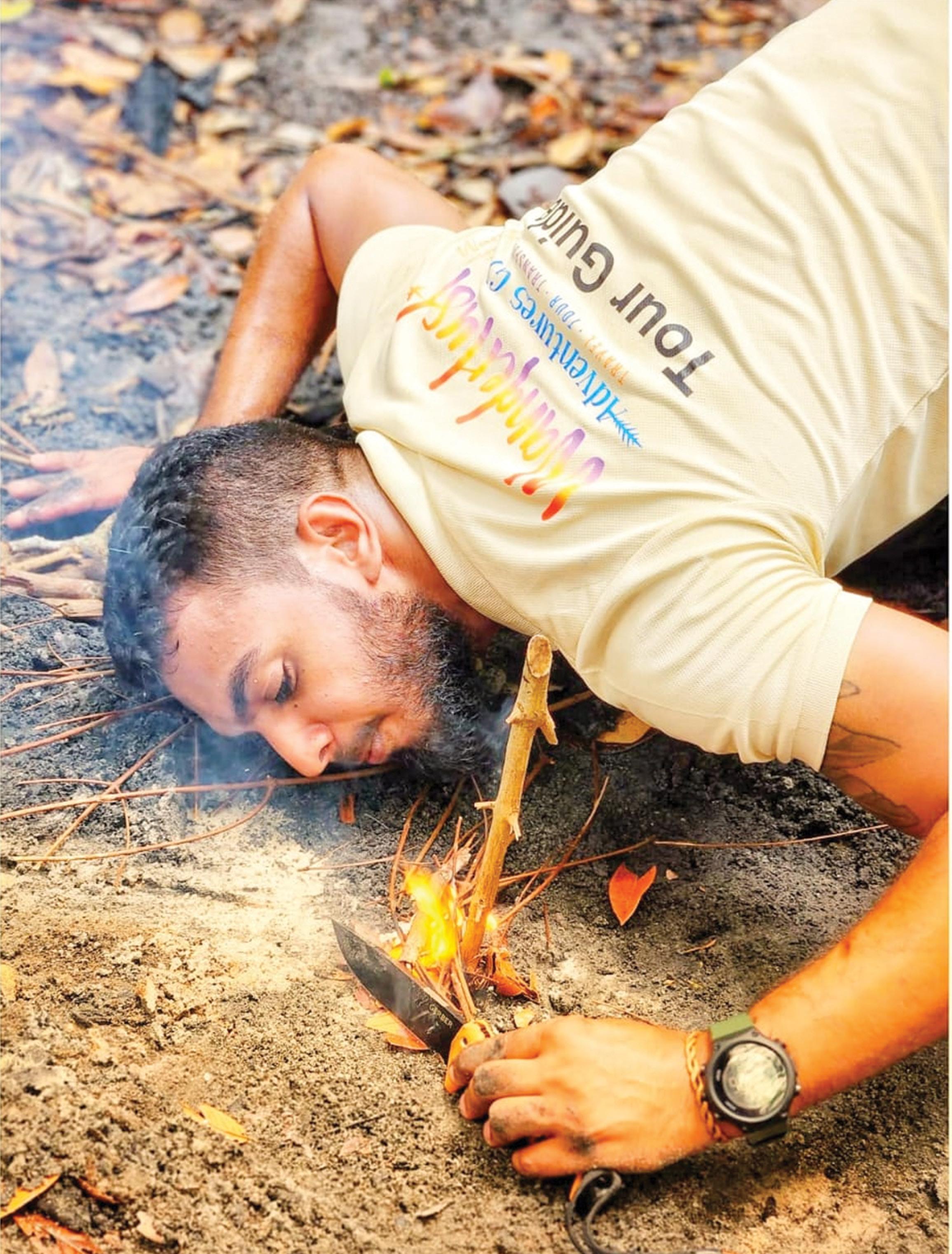



Young professional turns love for the outdoors into a full-time career as a tour guide
By Shaniya Harding
CHRISTOPHER Persaud’s journey from IT consultant to professional tour guide reads like an adventure story itself. A lifelong passion for camping, birdwatching, and the Scouts, combined with formal training in first aid, jungle survival, and crowd management, paved the way for a career that blends exploration with education.
Today, he leads immersive tours across Guyana, sharing the country’s rich history, vibrant culture, and breathtaking landscapes with both local and international visitors. From island-hopping
adventures along the rivers to remote jungle hikes in search of wildlife and artefacts, Persaud balances safety, storytelling, and unforgettable experiences—proving that guiding isn’t just a job; it’s a calling.
Christopher spent most of his professional career as an IT consultant before venturing into tourism about three years ago. The switch was unexpected, he says, although he always had a passion for the outdoors. He admits that he did not initially think his love for nature could become a profession.
The opportunity arose when the owner of Wanderlust Adventures asked him to
lead a children’s tour because of his extensive background in the Scouts. It was the first time Christopher realised that his passion could pay the bills.
“Being in the outdoors, after working in a box in IT for so many years, was always a passion. Especially being able to share it with other people—the stories, the history, how amazing and beautiful Guyana is, how incredible the wildlife and plant life are—and sharing that knowledge and passion with people from all over the world, and Guyanese as well, that was the true lure of it,” he said.
He added, “It never feels
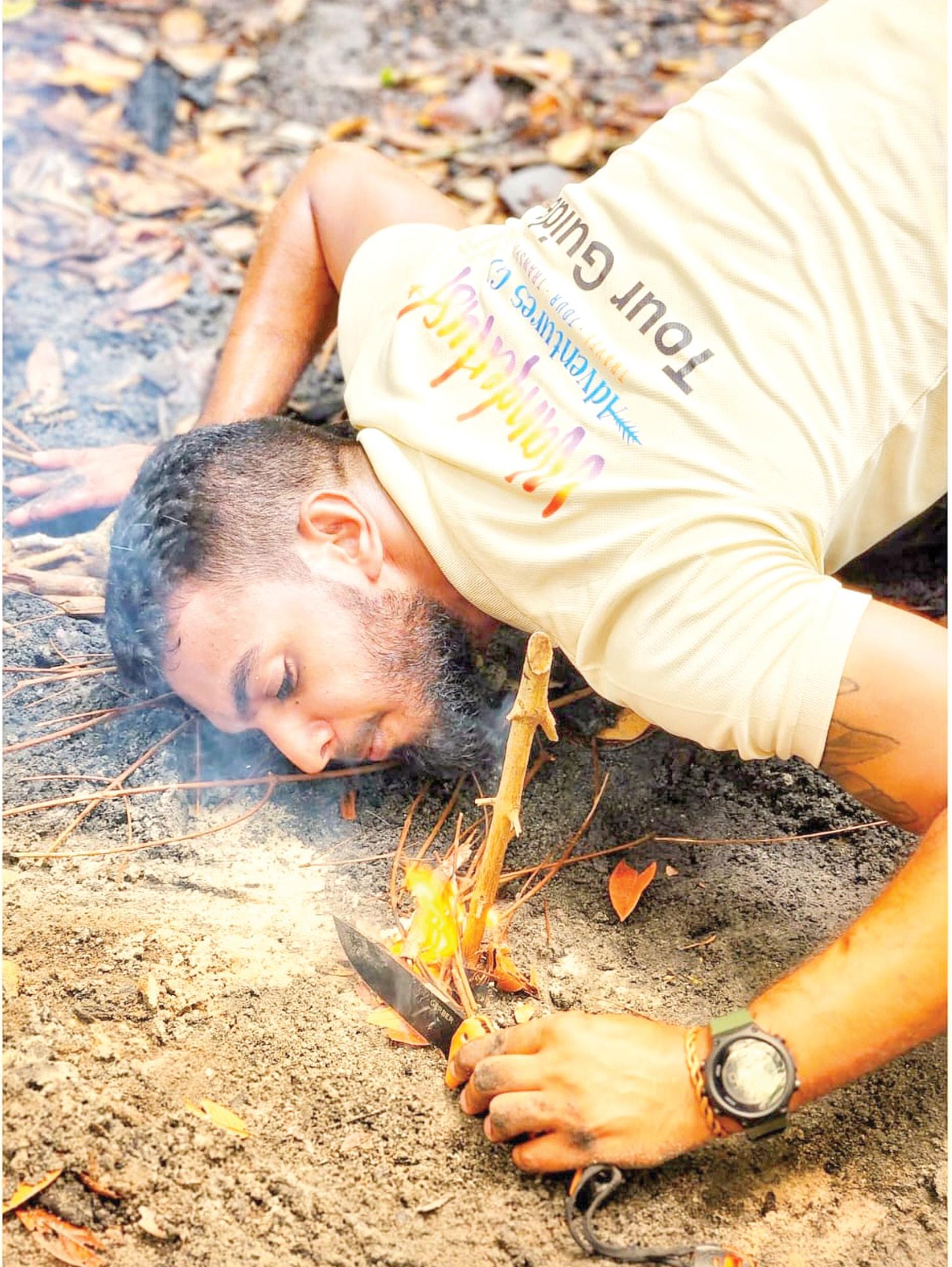

like I’m at work. It feels like doing what I always did on weekends—packing up my truck and going camping or exploring somewhere new.”
Today, Christopher is a licensed guide, coupling his passion for the outdoors with the expertise needed to take others on tours safely.
A typical day for him starts early, and many of his days are spent on the water, taking Guyanese and visitors on the Global 5 Island and Town Hopping Tour.
“My day normally starts at 4 a.m., getting everything ready, making sure the bus and coolers are prepped, and reaching out to guests the day
before to let them know what to expect. We meet at our office and provide transportation to Parika.”
He added, “We get onto private boats. Along the way, there’s so much to see: history from the 1400s and 1500s, historical buildings, architecture, birds, and more. I generally talk from Georgetown to Parika before the tour even officially starts, sharing that knowledge.”
Safety is of the utmost importance for Christopher, and once on the boat, safety briefings are a must.
“Safety is very important, especially on the river. We want everyone to have a great
experience, learn a lot, and get what they’re looking for out of the day, while avoiding any incidents. We make sure everyone knows the plan, knows who I am and my capabilities. We stick together as a group to ensure the day is both healthy and fun-filled,” he stated. At various islands and locations, Christopher shares history, introduces tourists to the people, and, of course, shows them the cuisine. But the adventure is not limited to Guyanese.
“We get a lot of Guyanese guests, but also people from the U.S., Europe, and Australia who have never seen some
TURN TO PAGE XV
Day, the creator of the BRAVE initiative reflects on his journey and what it means to create a safe space for men.
By Shaniya Harding
ON November 19, Guyana joined the rest of the world in celebrating International Men’s Day, a day dedicated to recognising men and highlighting the challenges they face. And while the day served as an observance, in Guyana, the BRAVE Centre has pioneered a safe space for men. Rawle Small, the driving force behind Guyana’s BRAVE Centre, traces the programme’s roots to his lived experience as a Guyanese man and to his years of work across policy, research, and community engagement.
Speaking to Pepperpot Magazine in observance of International Men’s Day, he said BRAVE emerged from gaps he repeatedly witnessed in how men were engaged, as well as the absence of safe, structured spaces for men to
discuss identity, growth, responsibility, and the challenges they navigate throughout their lives.
As he shared, “BRAVE, it’s in the acronym: Build your legacy; Reclaim your manhood; Activate goals; Visualise success; Execute fearlessly.”
He added, “The key takeaway is for us as men to be comfortable with who we are as men, not what anyone else says we are. Be your authentic self and build your legacy.”
Small launched BRAVE in July of this year on the ground floor of the West Central Mall in Region Three. While Small was the driving force of the project, collaboration with the Ministry of Human Services and Social Security and the Region Three Chambers of Commerce made the project a success. Small says the BRAVE project has been in the making for a while, an
initiative he says was sparked by his own experiences as a Guyanese man.
Small traces the roots of his work back to his early academic journey, recalling how courses in Gender and Development and Women in Development at the University of Guyana fundamentally shifted his worldview.
Those classes, he said, opened his eyes to the subtle but powerful ways gender shapes everyday life; how men and women experience transportation, employment, and even household responsibilities differently, often without realising it. The courses forced him to reflect not only on society but also on himself, prompting a deeper understanding of how he was socialised as a Guyanese man and how that socialisation influenced how he moved through the world.
That awakening pushed him

further into his career, leading him to pursue a master’s degree in Gender and International Development in Costa Rica, followed by a second master’s in Austria, funded by an additional scholarship. After returning to Guyana, Small immersed himself fully in youth and community development work, taking on roles with the United Nations Volunteer Programme and the Ministry of Culture, Youth and Sport, while also chairing the Youth
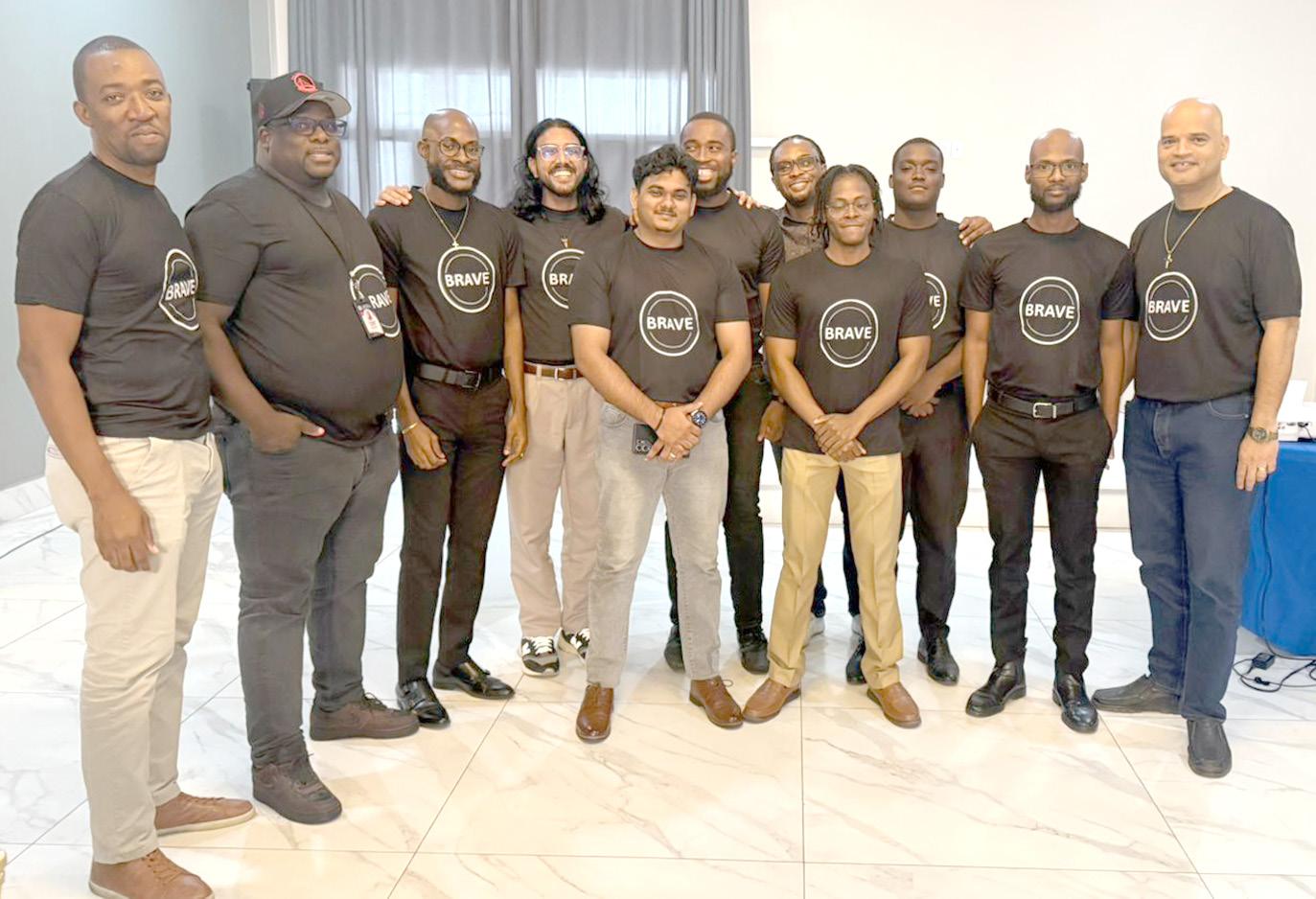
Policy Steering Committee. He volunteered extensively, especially at the drop-in centre for street children, where he worked closely with young boys and began to see more clearly the cycles of vulnerability they faced.
His team contributed to the family-violence study that informed legislative updates, and they later helped design the Hope and Justice Centres in partnership with UNFPA, the IDB, and the Ministry of Human Services. For Small, this work is deeply personal. “This work has really been part of me, and it’s part of my identity. It goes beyond something I do for a job.”
He is also quick to credit the women who shaped and supported his journey, including Dr Yvette Burke, Ambassador Carolyn Rodriguez-Burkett, and Minister Vindhya Persaud, noting that achievements rarely happen alone.
Small explained that one of the core strengths of the BRAVE Project is giving men a space to talk openly with other men about issues they rarely get to discuss. The sessions guide them through major life transitions.
As he shared, “We tackle the transition from a teenager into a young adult,” and later into middle adulthood. Moreover, BRAVE seeks to help men understand how to navigate relationships in healthy ways. BRAVE also focuses on grounding men in their personal values, teaching them to reflect on the legacy they want to build for their families, and showing them how to set goals and actually achieve them. The programme encourages men to identify their passions, develop financial literacy and the importance of saving, and understand their sexual and TURN TO PAGE V

By Michel Outridge
AT the beginning of the Diamond Housing Scheme in East Bank Demerara, residents know where to find fresh, high-quality meat.
Mahabeer Ramkissoon, affectionately known as “Boyee”, runs a bustling retail poultry outlet here, supplying freshly plucked chicken, duck, and mutton to a loyal community who return ,week after week, not just for the taste, but for the care and attention he puts into every bird.
“What keeps them coming back is trust,” Boyee says, carefully arranging
his chickens. “I make sure my meat is safe, fresh, and wholesome.”
He plucks on demand, never leaves meat in the sun for more than ten minutes, disposes of waste hygienically, and sanitises his outlet thoroughly before opening each day.
Farming has always been in Boyee’s blood. Growing up on his parents’ farm in Buzz Bee Dam, he learnt early how to care for goats and sheep, the rhythm of feeding, cleaning, and tending animals.Those lessons shaped his life, guiding him through the highs and lows of agriculture. As a young man,
he reared layer chickens on a large scale. But despite his dedication, setbacks came. Unvaccinated chicks, scarce vaccines, and disease wiped out entire flocks.
“I couldn’t continue producing unhealthy chickens for families. That was a hard lesson,” he recalls.Rather than give up, Boyee reinvented himself. Three years ago, after a major loss, he shifted from rearing his own birds to buying locally-grown meat chickens to pluck and sell, while also investing in small ruminants—goats and sheep—for the growing demand he saw locally and regionally.
Today, he raises Nubian mixed goats, and is developing a premium breed of sheep using Dorper and Katahdin genetics. “People are eating more protein now,” he explains. “I wanted to meet that demand and provide healthy, quality meat. That’s how I can contribute to my community.”
To properly care for his animals, Boyee has adopted intensive, climate-smart farming methods. Elevated pens keep his goats and sheep dry, comfortable, and hygienic, even during heavy rains. While the East Bank has no communal pasture, he finds creative ways to feed


his herd, cutting grass from backlands, and occasionally from roadways.
These small acts of ingenuity reflect the kind of farmer he is—resourceful, determined, and attentive. The new Buzz Bee Dam highway, which passes directly in front of his home and farm, has brought both challenges and opportunities.
“Animals must be kept safely away from traffic,” he admits, “but the road allows me to reach more customers, sell more meat, and grow my business. The benefits outweigh the risks.” The High-
way has also made it easier for him to serve his loyal Diamond Housing Scheme community customers, who trust him for both quality and safety.
Boyee’s journey has been strengthened by support from the Guyana Livestock Development Authority (GLDA).
He is particularly thankful for the Region Four extension team, including Dr. Nauth, Veterinary Officer, and Mr. Bhagwandin, Livestock Officer, whose guidance on disease management, feeding, and record-keeping has been invaluable. He is also grateful
for government programmes ensuring chicks are vaccinated before sale, significantly reducing mortality. “It allows farmers like me to focus on growing healthy animals instead of constantly worrying about losses,” he says. Always ready to embrace change, Boyee is particularly excited about the improved traceability system to be rolled out by the Ministry of Agriculture through agencies such as the GLDA.
“A system like this will help farmers track and record our animals properly, which TURN TO PAGE VIII

By Shaniya Harding
DESPITE more than a decade of living without the use of his legs, 50-year-old Tamesh Rambarran greets each day with bold optimism that refuses to fade. His life changed in an instant after a 2014 accident left him paralysed from the waist down, yet the man who once cut cane in the fields of Canal No. 1 has never stopped pushing forward.
The journey has been painful, slow, and often isolating, filled with long nights of discomfort, moments of doubt, and the ache of missing the life he knew. But beneath those challenges is remarkable perseverance. Tamesh has relearned how to move, how to manage, and ultimately, how to live again. Even now, after years of therapy and setbacks, he holds onto a simple but powerful hope: that one day he will rise, stand, and walk on his own once more.
Tamesh, or Tom as he is more commonly known throughout his community, was born and raised in Canal No. 1, a farming village located on the West Bank of Demerara in Region Three. His upbringing was similar to that of most Guyanese, with his early years marked by time spent outside with his siblings, exploring and playing in the Guyanese sun.
Like most men in his community, Tom went into farming at a young age. Not a lover of school, Tom ventured into cane cutting to support his family. “I grew up with my sisters and my other brother; I was the smallest,” he said. “I did not go to school much. My mother
died young, so I did not get to go to school. I went into farming.”
Tom found his calling in agriculture, going from cutting cane to farming, and eventually venturing into cattle rearing on his own. “I used to do plenty of farming, cut
grown.” During this time of his life, Tom had what many would call the perfect life; making a living to support a beautiful family. This would all change one evening in 2014.
The night that changed his life was like any other, says Tom.
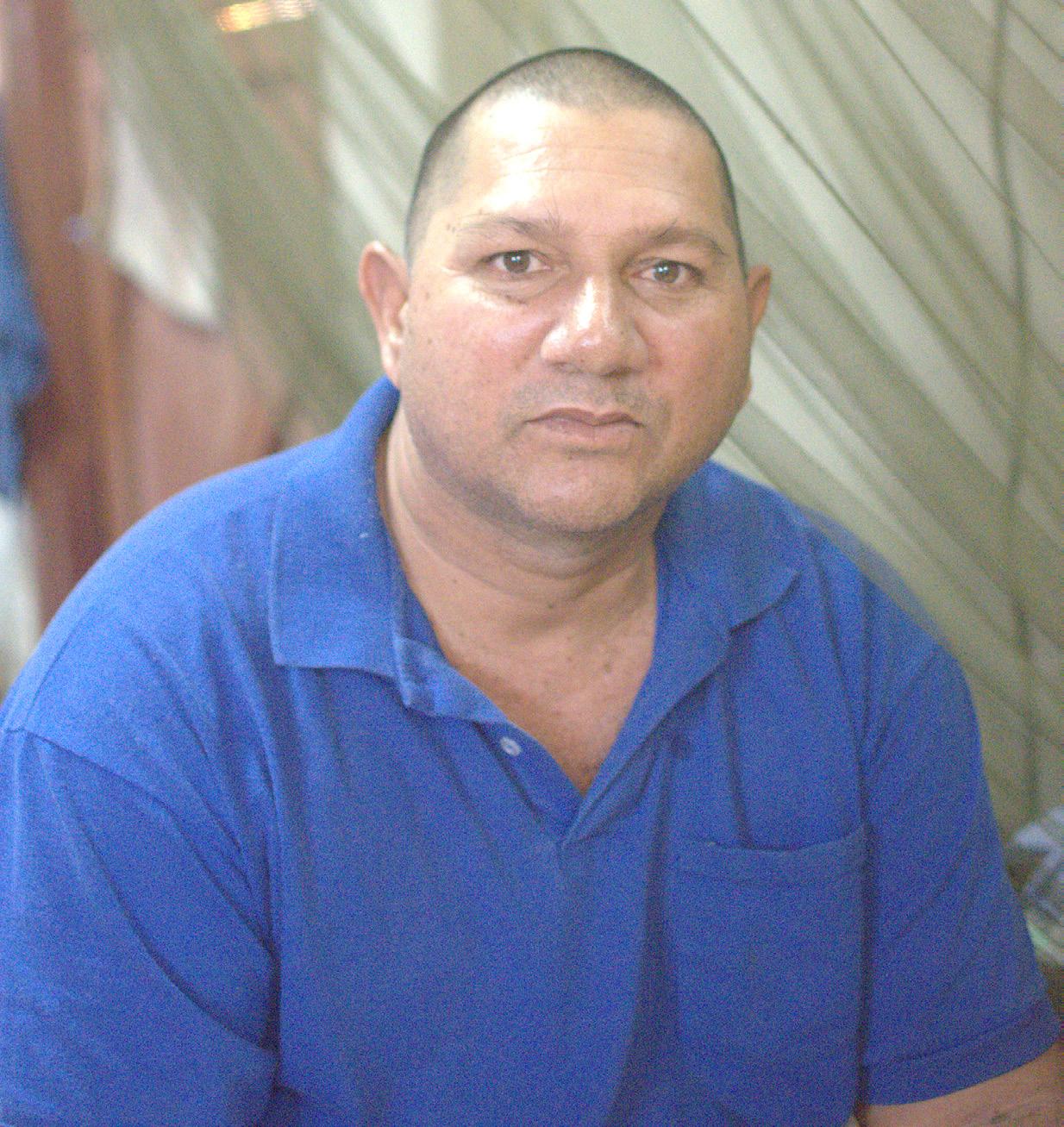
cane, and then I had my own cows. I liked farming,” he shared. Tom worked in agriculture to support his family. “I have a family, two daughters and one son. I used to farm and take care of them; today they are all
Accompanied by friends, he went out drinking a short distance from his home. Recounting the night, Tom shared, “That day I had done two jobs, and when I was finished, someone said we should go take a
drink. I was riding my bicycle when I fell off the bridge. It happened so fast, I did not even realise what happened, and I was left in that trench until morning.” Tom was found early in the morning when a friend he worked with came looking for him.
When he was found, Tom was very disoriented. Being a healthy, strong man all his life, he initially believed that he had suffered a cramp. “When I fell in, I was unconscious. I did not know anything,” he added. “And when they took me out, I was numb all over. I thought it was a cramp at first.” But Tom’s fall caused far more than a cramp—it almost completely paralysed him. When he was taken to the hospital, he received heartbreaking news: if he were to walk again, it would take years.
“When I got to the hospital and the doctor saw me, he said it is possible for me to walk again, but it would take years,” he shared. This was where reality struck. At the time, he was incredibly optimistic that he would be back on his feet within a few weeks, but therapy proved to be a bigger challenge than he expected.
Tom’s therapy journey was harder than he imagined. His condition was severe and required constant, rigorous therapy—something he could not manage without support. Recounting his challenges, Tom shared, therapy was hard, but it helped me a lot.
I can hold things better, I balance when sitting up better, and I feel stronger.” However, he was unable to continue therapy due to financial constraints and a lack of support. While his condition is
challenging, Tom cites the lack of support as the biggest hurdle, sharing that he has lost many friends and most family in the years following the accident. Despite these challenges, Tom’s optimism remains bright and inspiring. He navigates most of his day independently, cooking, cleaning, and caring for himself entirely at his home in Parfait Harmony. “When I get up in the morning, I bathe, make breakfast, and cook if I have to. Then I clean up and do whatever else I have to do.”
While Tom has learned to live independently, he says the emotional and mental impact caused by the lack of support has been one of the hardest parts of his journey. “I can do everything for myself, but I miss my life. I miss my friends; I hardly have any friends now. And even some family members do not come to see me anymore.”
Some days, Tom can be found on his motorised scooter, exploring his community and the familiar farmlands of neighbouring Canal No. 1. His story is not just one of struggle, but of resilience, determination, and the quiet power of hope. He continues to adapt, find joy in small victories, and inspire those around him with his unwavering courage.
“I take each day as it comes, and I keep moving forward. I still feel as though I will walk again, I cannot give up.” For Tom, life is about more than what was lost; it is about what can still be achieved and the optimism that lights his path. He is a reminder that even in the face of profound challenges, the human spirit can rise, persevere, and continue to thrive.
FROM PAGE III
reproductive health.
Terms such as “men as allies” and “toxic masculinity” are doing more harm than good, says Small. The key, he says, is to positively engage men—not as allies or potential threats, but as men. “Many men don’t have opportunities to talk among other men about things in life that might affect them. These include transitioning into adulthood, navigating relationships,
understanding values, legacy, setting goals, identifying passions, financial literacy, sexual and reproductive health, understanding rejection, understanding it’s okay to be rejected, understanding rejection does not mean you’re unworthy or have to retaliate.”
While still in its earlier stages, plans to expand BRAVE are already underway. As Small shared, “We will push forward to open
about two or three more centres next year. We engage with communities, identify the men, and set up a programme.
Each BRAVE Circle is designed to be 90 minutes. It’s a facilitating structured dialogue with men about different things. It’s not about fixing men. It’s about arming men with skills and tools to navigate different experiences at different stages of our lives.”
The programme is organised into four key modules: BRAVE Circles, Think Fuh Yuh Self, My Legacy, My Roots, My Life, and Support Through Sports. These modules guide men through self-reflection, personal growth, and healthy ways to navigate life’s challenges. As Small explains, “We are not asking permission to change, we are reclaiming what was stolen: our dignity, our strength and our power
to choose differently.”
The real impact of BRAVE lies in its simplicity and structure—giving men a truly private, safe space to assess their hurdles, then equipping them with the tools to tackle them and become better men. “This is important work not just for men but for society and communities. That’s why BRAVE stands for what it stands for.”
By Michel Outridge
IN the quiet village of Garden of Eden, where the morning breeze rustles through green fields and the day begins long before sunrise, Akram Inshanally walks the same lands his father once tended.
As a young boy, he followed his father through pens of sheep and the hum of farm life, learning lessons that would shape his future.
For Akram, farming was never simply a job; it was a love passed down through generations, a family legacy that grew with him, and eventually became his life’s calling.
Today, he is recognised as one of Guyana’s most respected small ruminant breeders, supplying farmers across the country with high-quality sheep.
The settlement of Garden of Eden itself has a story that mirrors Akram’s dedication. Established in 1959, villagers obtained land from the colonial government, transforming it into housing and farm lots; a vision later supported by the late President Dr. Cheddi Jagan.
Blessed with fertile soils, lush greenery, and fruit trees that many believe inspired its biblical name, the area quickly grew into a thriving farming community.

Today, it is known for largescale poultry, cash crops, and cattle and small ruminant rearing. Akram’s farm sits at the heart of this rich agricultural heritage, carrying forward a legacy rooted in the land.
“I’ve always loved animals,” Akram recalls. “Sheep and chickens started as a hobby, but when I realised it agreed with me, I took it seriously.”
That childhood curiosity has blossomed into a thriving enterprise. Although he paused sheep rearing for a few years, he returned to it full-time in 2008, gradually building his farm into the success it is today.
The defining moment came with the introduction of the Dorper breed into his flock. Initially, Akram sourced improved animals

himself and implemented a strict breeding programme to strengthen his genetics.
Through personal research, traditional knowledge passed down from his father, and guidance from the Guyana Livestock Development Authority (GLDA), the Dorper became the cornerstone of his breeding programme, helping him achieve 70 per cent Dorper genetics while improving growth, resilience, and overall quality.
While he is a recipient of a Dorper ram from GLDA under the National Genetics Improvement Programme, Akram is also a strong advocate for the government’s efforts to bring more top-quality breeds into the country.
“If we can get more top-breed animals into Guyana, farmers will benefit. It will spur growth in the industry,” he emphasises.
His own success—propelled in part by GLDA’s improved Dorper breed—now stands as living proof of the transformative impact of upgraded genetics on farmers across

Guyana.
Now, Akram manages 95 high-quality sheep, focusing on Dorper-mix breeding rams prized for their fast growth and resilience. Farmers travel from Berbice, West Coast Demerara, and East Coast Demerara to purchase his rams, often weighing 100 pounds by seven months.

“Sometimes the demand is so high, it’s hard to keep stock,” he admits with a smile, reflecting both pride and the challenges of meeting nationwide demand.
Akram combines tradition with modern livestock management. His pens are well-ventilated, the lambing areas are spotless, and bedding is regularly refreshed with sand.
He keeps rams separate from ewes to avoid inbreeding and meticulously tracks each animal’s lineage.
“Good record-keeping is essential—it’s part of my traceability system,” he explains. “It helps me maintain the pedigree of every animal and ensures the integrity of the breeding programme.”
Coupled with careful feeding—grass, molasses, and specially formulated “Textile” feed—his sheep thrive, becoming sought-after nationwide.
But sheep are only part of his story. Akram has diversified his farm to make full use of his land. He tends a coconut plantation of over
TURN TO PAGE XVI

- With
categories, mentorship, and a spotlight on
By Shaniya Harding
AFTER a two-year hiatus, cultural organiser and artiste, Franale Holder, is relaunching her long-standing creative platform with a sharper focus and renewed purpose. Known for championing young performers and giving alternative genres a home, Holder has returned to deliver a night transformed into a full-scale talent showcase. This time, the aim is to nurture and professionalise artistees across hip-hop, rock, reggae, dance, spoken word, and more. With a new team, monthly events, and a commitment to mentorship and artiste development, Holder says the event now reflects both her personal growth and the evolving creative needs of Guyana’s arts landscape.
Originally held several years ago, Franale’s HipHop and Poetry Nights offered a vibrant, bold platform for young creatives across genres. The event, last held
more than two years ago, catered to artistes of various art forms, becoming one of the first and most well-known avenues for spoken word poets and Guyanese hip-hop artistes. “The reason I created this was because there wasn’t even a space for hip-hop artistes, and I was a hip-hop artiste at the time. I used to sell my music on CDs. I was such a hustler. It was so others could be heard. I do see the ministry now doing dancehall and soca, but we can always use something more than once a year. That is why I took up the initiative again,” Holder stated. While the event was inspired by Holder’s own passion for the arts, she says its vision has shifted. Reflecting on her hiatus, Holder explained that the event is now better than ever. “I took a break because it became very overwhelming for me. I needed that break to mentally grow and realise that it’s not just me wanting to do well for

others and with others, but that it’s a business. I never looked at it as a business before. I looked at it like, I have good intentions, I want to take on these artistes, and I want to do something for them. That’s nice, but looking at it as a business is what will help it grow and provide the finances to keep the engine running consistently,” she added.
Some core elements of the event still remain, however. As Holder explained, Franale’s nights are still about the development of art. She and her team aim to give more artistes a space on stage with the creation of additional categories. “I’ve created more categories and everyone is ecstatic about that. I have performers who started with me who now have blossoming bands in rock, reggae, and more. I’m proud. I needed to get into the mindset that it’s a business and you can do more. It does not just have to be mentorship or training. You can teach them how to turn themselves into a brand that is functional in and outside of Guyana,” Holder stated.
While opportunities exist and growth is happening, Holder, like many other Guyanese creatives, would like to see greater local support. She described Guyana as a beacon of talent, overflowing with young people who are passionate but lack a stage to share it. “We do not have anybody egging us on. People think it’s cute and we get left in the sauce.
So you have people who either give up on their music or don’t see a way out because nobody is there to show them how to do it. Yes, there are classes, but many keep it classical or soca or calypso. Guyana is a beacon for all beginning artistes, and I didn’t realise that until I started to travel. If you go as a Jamaican artiste and you don’t get booked in Guyana, people there don’t consider that you’ve made it. We here don’t even know that,” she added.

Franale’s nights promise to return with a bang, featuring fresh, vibrant talent and seasoned professionals. Holder says the event will have something for everyone: “Poetry is something the older generation can enjoy, but there is more than poetry. We have people playing bass guitars, rock and roll, people who can actually sing. Why don’t they deserve a platform? They’ve always been there. Even hip hop. I didn’t even know Guyana had a hip hop breakdancing team,” she added. “It is for everybody to perform comfortably in their category and excel. The name stayed the same because people know it as that. People working shifts still bring their pieces and want to perform. They like healthy competition.”
The relaunch will take place on Friday, November 28, 2025, at the Transport General Sports Club
in Thomas Lands, opposite the National Park and next to Malteenoes. The venue offers ample parking, food vendors, cold drinks, and mixologists to make the evening as enjoyable offstage as on. Holder has introduced new categories to accommodate the growing diversity of performers, including hiphop (including Creole rap), slam poetry, dancehall, and a Wildcard section embracing interpretative dance, gospel rap, soca, rock, R&B, and chutney.
The event kicks off at 7:30 pm with music from Blue Flame Sounds, selector Ricky, and DJ Mighty Mike, while One Thyme Media and The Unspecialist cover photography and videography.
“We’ve always done it with the old school band system.
If anybody wants a band before the show, they can call 637-3554. But we’re not raising prices at the door, so
just come on the evening and collect your bands. We have security. Smooth flow in and out. It’s great for networking because you meet all calibres of people,” Holder shared. Admission is $2,500 GYD, with group rates of $10,000 for five and $20,000 for ten. Holder emphasises that the show is for everyone who loves music, performance, and supporting local talent.
“If you enjoy good music, no matter the genre, come out and try it.
The environment is cosy and comforting. You feel nice, drink something, and enjoy the show.” With a decade of experience behind her, a re-imagined structure, and a clear focus on mentorship and celebration, Holder’s relaunch promises more than a stage; it’s a community, a platform, and a home for Guyana’s growing pool of creative talent.

HAVE you ever found a noticeable crack in your house? A small, hairline fissure on the surface of your wall, perhaps? Or you may have seen a crack on your floor, running across a tile in a corner of a room you generally do not use. The crack may have been quite noticeable— but only to those not accustomed to seeing it.
To you, the crack has become a part of your natural environment. In fact, it is no longer even a crack or an indication of damage, but simply a feature of your home—no different from the orientation of your furniture or the colour of your walls. After a certain amount of time, you do not even notice the crack, much less think
about remedying the issue. However, one day, you notice that the crack has widened. It has spread across a large section of your house now, much like a seed that has sprouted roots. Will you continue to let it grow?
Our world is peppered with many noticeable cracks across its seemingly smooth surface. Throughout our lives, nearly everyone in our population encounters these cracks and has the chance to learn about them. However, once they have finished learning about them, the cracks are forgotten and left behind to grow. They are seen as a natural part of the environment we live in, and remedying them is believed to be a Herculean task whose costs far outweigh the
benefits. It is not ignorance that guides this behaviour, but sheer indifference and a disconnect from the reality of the depth of the problems that plague our world. We have simply become so used to seeing the cracks that they no longer seem like a problem to us—especially not when they do not have a direct effect on us.
When we learn about certain periods in the history of our world, we tend to experience a mix of deeply unpleasant emotions. We are disgusted by the injustices that people in the past have suffered. Most importantly, we find ourselves asking the same question over and over again: why did so many people go along with those injustices? In a world filled
with both good and bad people, why does history seem to record periods where the ‘good’ people never stood up to injustice or at least refused to go along with systems that oppressed innocent people? Across different countries and in different situations, there have been significantly long periods when unspeakable atrocities were committed against human beings.
However, in those eras, those cruelties were seen as nothing more than cracks on the surface of society—normal parts of the world that did not need to be remedied unless they began to affect the greater population.
The truth is, so many people went along with cruel systems because they refused to spend the energy to under-
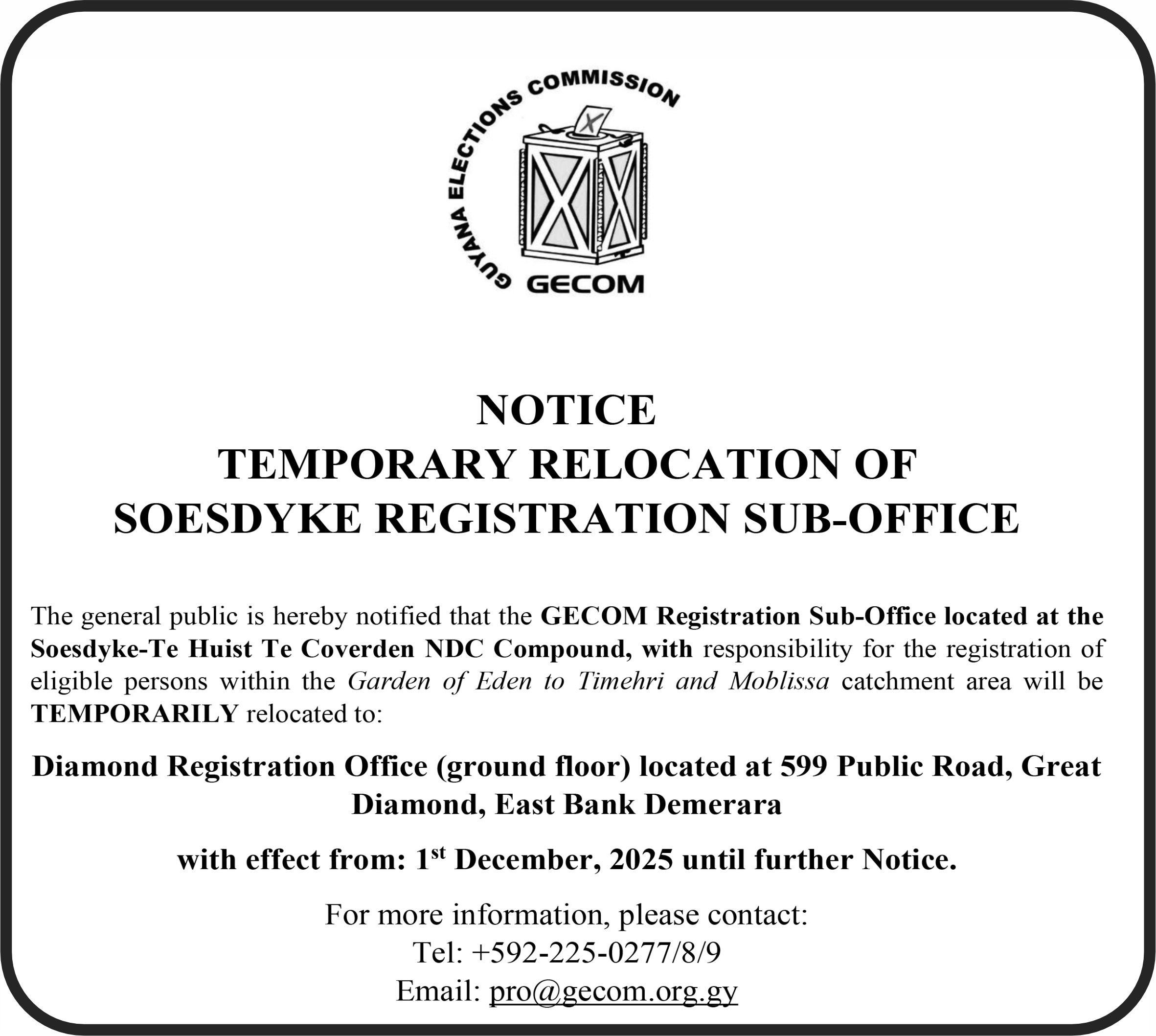
stand the very real effects those systems had on fellow human beings. After all, it is easier to ignore cracks than to discover the extensive and dangerous damage hiding beneath the surface.
We are not so different from our indifferent predecessors. We too have adopted the habit of ignoring and overlooking issues that do not have a direct impact on us—especially if speaking up is not considered socially acceptable.
Although Generation Z has already proven itself to be quite proactive in speaking up about important issues, there is still so much more we can achieve together. While calling attention to a problem
is crucial to remedying it, we must continue working to develop innovative solutions to eradicate those issues entirely.
We can start by helping other generations see issues as much more than surface-level cracks. Showing each other the reality behind so many problems can help garner help towards solving them.
Similarly, we can also start by patching up the cracks in our own homes and communities—admonishing unjust behaviour whenever we see it. In this way, we can create real change. All we need to do is stop ignoring the growing cracks.
is good for everyone—producers, consumers, and the country,” he says.
The development of a traceability system aligns with the Food Safety Act 2019 and Guyana’s National Food Safety Policy, which emphasise the need for traceable, transparent, and accountable food production systems.
Looking to the future, Boyee also hopes to participate in a ram/sheep rotation programme that would allow farmers to improve genetics in their flocks, raising the quality of locally-produced meat even further. Meanwhile, his poultry business continues to thrive.
He buys 250–300 chickens at a time, plucking them fresh for customers, and during holidays, ducks are also in high demand.
Despite the popularity of his meat, he proudly maintains fair prices. “I believe in supporting local production.
Families deserve quality
FROM PAGE IV
meat at affordable rates, even during the busy season,” he says.
“This is a new era for farming in Guyana,” Boyee reflects, looking over his flock of goats and sheep and the chickens lined up for the morning rush. “We are not just producing for ourselves; we are producing for our country. And that makes me proud.”
As the festive season approaches, Boyee’s chickens, ducks, goats, and sheep are ready for families across East Bank Demerara.
His story—from early losses to innovative, climate-smart livestock farming, meticulous food safety, engagement with extension services, and readiness to adopt traceability—illustrates how resilience, dedication, and a commitment to local production can turn challenges into opportunities, feeding both stomachs and pride across the nation.

SOMETIMES, close friends can become strangers—or, even worse, enemies. Because there is no outward way of discerning who is an enemy and who is an ally, people must rely on their own instincts and keep an eye out for consistently problematic behaviours. Indeed, enemies often reveal themselves through their actions.
Manipulation, peer pressure, inflated confidence, a penchant for gossip, and dishonesty are all trademarks of toxic people. Too frequently, people fall into unhealthy, co-dependent friendships, and they do not know whether they should fix the relationship or walk away for good. Learning how to recognise and address these harmful behaviours can prevent a friendship from becoming unsalvageable.
Maintaining friendships is never easy in the best of times, but if someone feels as though their friend is actively deceiving, exploiting, belittling, or controlling them, they have one of two options: either remove themselves from the relationship or try to repair it. If they choose the former, it is important to be as gracious as possible; after all, former friends do not have to—and should not—become enemies. If they choose the latter, both parties must be willing to forgive, accept each other’s boundaries, and communicate more openly with one another. With this book, people will learn how to identify and confront toxic behaviours before they ruin a friendship.
1. What makes friends become enemies?
People do not set out to be enemies, but many things can happen that turn friends into foes. When friends become enemies, it often hurts because it reminds them of the enjoyable moments they shared together. They remem-
ber their days of laughter and sharing the same space.
Those who enjoy friendship know it has helped them many times deal with the stresses of life. Through friendship, people can share their problems and benefit from their friends’ wisdom.
Some friendships are so dynamic that friends can say whatever is on their minds without fear of insulting the other person. However, not all friends will accept an insult. Just one insult may be the end of some friendships.
Even when friends have grown to love and respect each other, some people still betray them. When those closest to you betray you, it often causes much internal pain. Many people do not expect their very dear friends to betray them, but it often happens.
Not everyone is happy with the wealth their friends have. So, one friend may steal from another, and that will cause them to become enemies. Some friends were very reliable at the beginning of a friendship, but as time progressed, they became unreliable, causing their friendship to drift apart.
Egos and narrow-mindedness have destroyed many friendships. Narrow-minded friends often see things from their own limited view and are not open to suggestions from others.
Willingness to rebuild a friendship with enemies
After friendships have been destroyed, it is important to rebuild them. People should not live as enemies for the rest of their lives. They must make efforts to reunite. It may take some time for the friendship to be restored, but it must start somewhere, and at the earliest opportunity. Forgiveness is essential in helping enemies become friends. Each person must be willing to forgive those who wronged them.
Counselling may be necessary to help enemies become friends. When seeking counselling, people must look for unbiased mediators. Family members may not always be good mediators, since they may have biased views.
When enemies forgive each other and are prepared to rebuild their friendship, they must learn to respect each other. They must establish boundaries to help their friendship grow, since they do not want to destroy it again.
Honesty is essential in helping friends trust each other. They must have open and honest communication. While they communicate, they must speak the truth. Learning each other’s non-verbal communication will be important to help the friendship grow, as it helps them understand each other even when words are not spoken.
Going places together often strengthens friendships. Friends can plan a vacation together, so they get time to communicate. During that time, they can cry or laugh about different situations.
It is best to have more friends than enemies. When friends are reunited, efforts must be made to maintain the friendship and avoid becoming enemies again.
1. Have vacations together
Some friends who cherish their friendships will plan vacations together. This will allow them to go places together and to learn and laugh together.
With regular interaction, there is much they can learn from each other. When they are on vacation together, they can share many ideas. They have great opportunities to learn from each other.
Being on vacation allows them uninterrupted time together. Sometimes they will have opportunities to discuss


MOST times, we—the casualties of changing times—do not recognise that it is not only change, but adjustment, that may require bridges of collaboration through one’s own recognition, in order to embrace a not-so-popular or challenging aspect of one’s dream scheme of yesterday.
Ideas, or the idea that we cancelled and left outside because of the energy required—encouraging us to “put it aside” due to the prospect of too much effort or the
finances needed to create the atmosphere—were shelved while we pursued other manageable areas to make ends meet.
However, the platform towards transforming that shelved volume of hard work into its competitive challenge now beckons in the obvious present; it is here that relevance is most necessary.
Thus, when the common becomes infiltrated and new challenges impact the accustomed weather, the inevitable, shelved choice be-
comes aware, tingling and propelling. But this is the time for greater caution, because you have to fill the time lost, for the layouts of the past have to be adjusted.
Again, I repeat: during my time working at the Chronicle newspaper, taking care of advertising over-the-desk artwork, one of the managers implied that this machine-computers--would make some of our tools redundant.
Our current world is not far different. We, like every former
colonial society, are facing social developments that will require the formation of examples needed to adjust attitudes and certain influences. Any area of cottage industry or local-social theme operatives in discussion—as may exist in this case—regardless of how useful, will definitely require the involvement of not only functional, knowledge-based individuals, but also those with specific talents for practical engagement when, or if, that time comes. I sense that, with
serious human issues, participation by all relevant parties is required. So far, the presentation I’m referring to does not contradict any of that, except to indicate that references do include social influences, and that such require support and time to evolve, with clarity forming and being agreed upon at the most appropriate time.
In closing, I will do my part to place on the cultural platform what was long overdue, in the interest of that need. Keep reading.


ALISA answered the dispatcher’s call to pick up a passenger at a Georgetown café on Middle Street and drop them off at Oleander Gardens on the East Coast Demerara. It was a Saturday, and traffic, as usual on that weekend, was heavy, but she had learnt to navigate the roads, saving time and staying within the law.
She was a young female taxi driver working from a base in Sheriff Street; not a job many women her age would opt for, given its male-dominated nature and the dangers posed by certain elements in society.
But fate had interrupted the smooth flow of her life when her father, a truck driver, met with a terrible accident. His condition had been listed as critical, and, with daily visits to the hospital to support her emotionally fragile mother, the company she had been employed with informed her she was not entitled to any more leave. Alisa, regrettably, had to resign from her corporate business manager role to dedicate her time to her parents.
Her brother and sister, living overseas, could not leave their jobs and families for too long and instead offered financial assistance, which did not come regularly enough to cover the medical bills.
Her father survived, but with extensive damage to his legs that left him reliant on crutches. He could not work
again. It required months of physiotherapy and exercise, which further increased the medical bills.
That became deeply worrying for Alisa, as she considered several options for working independently and avoiding a day job. One of her good friends had teasingly suggested the taxi job to her, and Alisa, looking at the daily earnings, thought it was a great idea. Her mother, however, was worried about the dangers of the road and the possibility of hijacking.
“It’s not a safe job for a young woman,” she had expressed with concern.
“There are challenges in life, mother,” Alisa had explained, “and we have to take it in stride, set goals, and work towards achieving success to survive.”
“God bless you, my dear child, for being so bold,” her mother had said, with tears in her eyes.
Her father had cried, too, that morning when she left for her first day as a taxi driver.
“If only that accident hadn’t happened,” he rued.
“It’s okay, Dad,” she had assured him. “We do not design our lives; fate does, leaving us to fight battles.”
She went to work that morning with the second-hand car her father had gifted her for her eighteenth birthday.
“From a corporate business manager to a taxi driver,” she voiced quietly. “Here

we go.”
Her first day was fine, with the dispatcher sending her on short trips. She went home for lunch, checked that her parents were doing okay, and left work at 4 p.m.
“Not bad,” she had sighed, “each day will be a different day.”
And as the days went by, she went on longer trips. Of course, there were the inevitable questions and comments from passengers:
“Why is a young girl like you driving taxi?”
“Are you married?”
“Can I have your num-
ber? We can probably go out sometime.”
And there were the sexist and misogynistic male drivers on the road who commented negatively on her driving. She took it all in stride, for it was a job she chose and had to make work, as her earnings paid all the bills and put food on the table.
She worked every day except the day she had to take her father to the doctor, and she took Sundays off. She did not have much of a social life, but met her three best friends from high school for a TURN TO PAGE XVII



VISHNU eased back in his chair at the game after landing the Double Six. He avoided the stares of Afzal sitting to his left, and Peter, sitting on his right. The next play, moving in a clockwise direction, was to be made by Afzal, then Peter, and back to Vishnu.
Afzal flexed his bulky chest and arms, as if preparing to control the mules belonging to the Leonora Sugar Estate. His job of minding the six mules was unique, and began when they were retired and replaced by tractors to pull the punts with the cut sugarcane from the fields, along the canals, to the weighing site of the factory.
Every year, when there
was the local sports day at the Leonora Park Cricket Ground, a special race track was cut out at the unused land beyond the northern end of the cricket field. The mule race was a special treat for the spectators, and Afzal’s mastery in controlling the six large animals was a spectacle in its own right.
The mules responded to every command by their keeper, and were soon ready for the race. This began with the official starter firing his pistol raised high above his head. The starter then made a frantic dash to get well out of the way of the galloping giants, much to the delight of the spectators.
Other events on the day
were the “Greasy Pole” climb and the “Catch the Greasy Pig” race.
The greasy pole was a metal pipe of about twenty feet long and four inches in diameter. It was covered in black grease and placed over the trench that flowed on the right-hand side of the cricket ground.
The competitors had to climb along the pole and grab a prize firmly tied at the end, dangling high above the slow-moving, murky water of the trench.
The crowd was well entertained as each competitor tried their utmost to crawl along the pole; they quickly lost their tenuous grip and plunged into the trench.
Eventually, as further

attempts were made and the grease slid off the pole, one determined climber would succeed in reaching the end. The winner would grab the prize and, much to the delight of hundreds of spectators, dive into the trench whilst holding the prize aloft.
The greasy pig race consisted of a continuously squealing specimen, covered liberally with black grease. The pig would be given a fifty-yard start to run for its freedom.
The chasers made their mad dash to catch the pig with their bare hands, failing time and again. The pig would scamper amongst the spectators in its frenzied effort to escape the chasers, causing much mayhem as people tried to avoid being soiled by the animal. The eventual winner would successfully catch and hold aloft the screaming pig as the prize.
Peter glanced at Afzal, then fixed a gaze at Vishnu, who bowed his head and avoided eye contact with his rivals. The players were not allowed to speak, and the spectators were encouraged by the referee to remain as silent as possible.
Michael turned to Arthur, standing next to him, and whispered, “The Double Six is the best domino to draw in the game, simply because it has to be played before any other, and also, this means that Vishnu has already gotten rid of one of his seven dominoes.
Besides, the number sixty-six is very significant in our history. On the 26th of May 1966, we became an Independent Nation. It was the birth of Guyana. We were not British Guiana anymore. We were free!”
Some of the spectators overheard Michael’s whispering and stared at him, urging him to be quiet. He ignored them and continued his historical commentary.
He said, “You see, our President was then the Premier, and then he became the Prime Minister on that fateful day.”
Arthur brushed Michael

aside and said, “I know all about this. What has this got to do with the game of Dominoes? Please keep quiet and watch our own leader and master of Dominoes at work.”
The referee turned around momentarily and felt pleased that Arthur had helped him retain silence amongst the spectators. He quickly refocused on the game and awaited Afzal’s play.
Carlos winked at Michael and whispered, “So, we became independent from our British masters, only to go on fighting amongst ourselves?”
Michael smiled and said, “This battlefield is full of brothers, close relations, and friends from our three villages. Sometimes I agonise about why we must do such battles against each other. What benefit can we gain from humbling others?”
Nazir said, “Yes, let us prepare to watch our leader do battle, and not spare his opponents. I only wish to celebrate an ACES victory.
I do not care about the losers.”\ ***
Ramesh Prashad, the nineteen-year-old only son and child of Vishnu and Parvati, glanced at his wristwatch, scanned the room briefly, and after staring at his father, quietly slipped out onto the roadside. He mounted his 250cc Kawasaki motorcycle and roared off eastwards in the direction of Cornelia Ida.
Michael looked at Vishnu and caught him smiling with some pride. He said, “My friends, there goes our ACES captain’s dashing chip off the old block! Young Ramesh was born in May 1966, and is a greater gift to Vishnu and Parvati than our country’s Independence!”
Nazir smiled and said, “That young man must have many more important things to do than to stand around here to witness this game.”
Carlos nodded and said, “Hmm, I wonder what he is up to now.” Continued next week…

SASENARINE Persaud has always been a titillating writer. The author of over 15 books of fiction and poetry, his vast oeuvre is defined by the old poetic axiom, “make it new.” His poetry achieves a height of surprise through deft turns of phrase, evocative imagery, and layered representation of ideas. He is the coiner of the term “Yogic Realism”, which—as his poetic output suggests— engages deeply with Hin -
du religion and mythology, lending added resonance to his work.
It accounts for his poetry’s philosophical, mythological bent, which can be densely allusive. This is certainly true in his incantatory piece, “Waiting for Yamraj,” a threnody of sorts from his new collection, Mattress Makers (Mawenzi House, $20.95), which was awarded a Guyana Prize in 2022. As in some of his best works (In a Boston Night and Monsoon
on the Fingers of God come to mind), the new collection has a wonderful compression of form and language, squeezing expected grammar right out of the poems. There are no periods at the end of many poems in Mattress Makers. This omission suggests a continuation of themes from one poem to the next.
There is an almost granular way of seeing in the poems, all of which demand that you look closer, reread

and re-evaluate. What is the collection about? It seems to be about everything—the salient and the mundane. Take “Four Miles in Flatwoods Park,” for example, where a simple drive opens literal floodgates of things to forget, which the poem remembers. It is a remarkable illustration of how the mind latches on to things, capturing the small and the
large as it passes through:
We will forget the job cuts, the new database
A hawk gliding to a limb without flapping
Chirping wrens bobbing up from grass
Freshcut in summerlike winter afternoons
The machine’s metal tracks a tank’s Imprinted in the damp slope
the cleared bottom
At the foot of trees mulched stumps, hundred Feet oaks and pines sawdust—remember Katrina
Every beauty every named demonised in a storm
The levees around New Orleans breached
Because roots penetrate dams—flood water
Widening cracks into flood
TURN TO PAGE XVIII


be for just a few hours, as friends go to a place where they can be comfortable. Some friendships grow to the point where friends plan vacations and invite their immediate families. When families gather together, they learn from each other, and soon the friendship expands to include many like-minded people.
2. Visit each other Growing the friendship will include visiting each other. For example, on the weekend, one friend
may ask the other for permission to visit. On holidays, friends may also plan visits.
If friends live far apart, then they may not be able to have frequent visits.
However, even if they meet only once per year, they must visit each other. Some things can be discussed over the phone, but other matters are better addressed face-to-face.
Building friendship requires sacrifice. Friends will have to give up some of their time to be with
of the food we have. Keeping the interest of an entire group of 25 people—with different expectations and interests—throughout 12 hours, and getting them back home safely, is part of the challenge I love.”
Despite the excitement and vibrancy tour guiding brings, it also comes with challenges. Among the major hurdles Christopher and his fellow guides face is ensuring the safety of groups of passengers, some of whom are more adventurous and willing to take risks than others.
“Sometimes you have a great group where everyone’s on board, and then there are days where you have to work harder to maintain interest and safety. Some people want to do their own thing, go off on their own, and you have to keep the group together.”
He added, “As a guide, I have to be firm, but professional and gracious.”
While Christopher’s tours rarely see an incident or injury, he emphasised that it is important for a guide to always have a backup plan— even for things outside of his control.
“Very rarely, someone might get a cut on their leg at a waterfall, so it’s constantly monitoring for hazards. For incidents beyond your control—like engine failure on a boat—you always have a backup plan. We have another boat on standby to arrive in ten minutes, keeping guests calm and reassured.”
Remote jungle tours demand even more vigilance.
“I’ve had to use lifeguard capabilities, first aid training, and compass work, especially on remote jungle tours, hiking for artefacts and wildlife. You have to know where you’re going and keep tabs with teammates. You don’t do it alone; it’s always a team
each other.
3. Play games together
Playing games together provides an opportunity for one person to learn about their friend’s sporting skills. Some friends are often confined to work and the home, so they may not have any sporting skills. However, they may develop skills with regular practice.
Those who practise and compete against their friends may be more comfortable letting their friends
effort.”
Christopher is a strong advocate for tourism as a career—and not just because it is fun.
“I would encourage anybody to become a tour guide if it’s something you’re passionate about. There’s a niche for everyone—history, wildlife, storytelling, cuisine. You don’t necessarily need survival or lifeguard skills; you just need to share the story and make experiences come alive. The industry is growing. More people are visiting, more tour companies are opening or expanding, and there’s a variety of tours available.”
For aspiring tour guides, he recommends connecting with established guides, companies, or the Guyana Tourism Authority.
“They guide you through the licensing process—classroom sessions, crowd control, speaking to guests, first aid, bird guide licensing, and more. You do your own research on the information to share, but with their support, you can grow and advertise yourself as a tour guide.”
This Tourism Awareness Month, Christopher is advocating for more Guyanese to explore their country.
“If you are Guyanese, stop thinking of tourism as only for foreigners. Get out there, do a tour, learn about our own country, and you won’t regret it.”
Through his work, Christopher Persaud has proven that following your passion can open unexpected doors. From IT cubicles to the rivers, islands, and jungles of Guyana, he has transformed curiosity into a career—guiding others to discover the beauty, history, and culture of his homeland while living his own adventure every day.
see their weaknesses than letting strangers see them. Friends who are skilled in certain sports may be patient enough to teach their friends to improve.
In some games, all friends may be on the same side as they compete against other teams. In others, friends will have to compete against each other.
Whenever they finish playing--together or separately--they must commit to remaining friends afterwards. Unfortunately, some
friendships end after competitive games because one person cannot accept defeat.
Not everyone is willing to lose to someone they thought they would beat.
For more information about Geary Reid and his books: Amazon: http://www.amazon. com/author/gearyreid Website: www.reidnlearn.com
Facebook: Reid n Learn
Email: info@reidnlearn.com Mobile: 592-645-2240

1,450 trees of improved varieties. By efficiently managing this plantation, Akram meets the growing demand for fresh coconut water both locally and regionally, com-
bining sustainable land use with profitable diversification.
Building on the same principles of careful planning and meticulous management,
FROM PAGE VI
Akram has applied his expertise to his poultry operation, which is equally impressive.
As a contracted farmer for Royal Farms, he currently raises 73,000 chicks. He

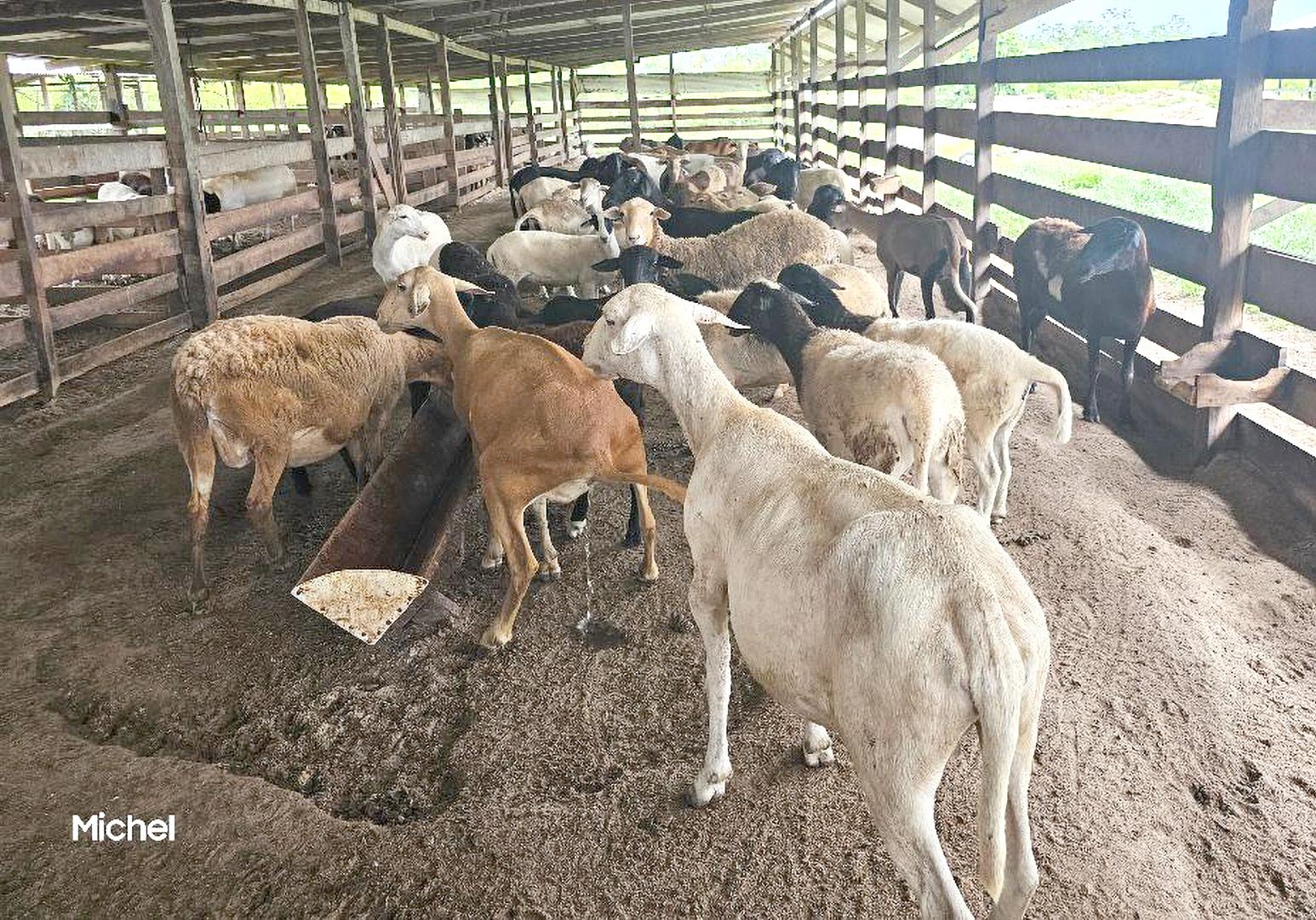
credits his success to precise animal husbandry practices, including proper brooding, well-ventilated pens, and high-quality chicks supplied by Royal Farms.
All birds are fully vaccinated to prevent mortality and ensure strong, healthy flocks.
With this careful attention, Akram ensures local consumers have access to quality, locally produced chicken—especially during the busy holiday season.
Through it all, what brings Akram the greatest pride is seeing his sons embrace the family tradition. His eldest works alongside him daily, learning the intricacies of sheep breeding, coconut cultivation, and poultry management, while his younger son, still in school, joins whenever he can, eager to follow in his father’s footsteps.
“Having my sons en -
gaged in farming is the best thing that has happened,” he says, his voice warm with pride.
For Akram, it is more than passing on skills—it is about instilling values of responsibility, patience, and respect for the land and animals.
Watching them grow, take ownership of tasks, and develop their own understanding of modern farming gives him hope that the legacy his father began will not only continue but also evolve.
With his sons by his side, improved genetics in his flock, and diversified operations that include coconuts and poultry, Akram is not just maintaining a family tradition—he is shaping the future of farming in Garden of Eden, ensuring the community he calls home will continue to nourish the nation for generations to come.

FROM PAGE XI
movie or a few cocktails. Tricia was a detective, and Sandy worked with the Ministry of Social Services— young professionals with dreams and ambitions. Alisa could have felt down, not being in a recognised profession anymore, but she didn’t.
“It’s amazing, your positive attitude,” Tricia told her. “Happy to be your friend.”
“Me too,” Sandy joked. “Cheers.”
The girls lifted their cocktail drinks—cheers to good friends and positive vibes.
Alisa continued her taxi work and, because she was a safe driver, she got many special hires but did not take long trips. Life improved on the financial side, and so did her father’s condition, as he began walking with the crutches less.
“But you know you’re not going to drive again,” Alisa told him.
“I know,” he assured her, “but I’ll find something else to do, not strenuous.”
She smiled and hugged him. “See you later.”
That day, she had a special hire to take a couple of passengers up the Highway and had dropped them off, turning to return when she heard a terrified scream.
She braked, and, looking through her rear-view mirror, saw a woman with a child in her arms, blood on her skin, running and screaming for help.
“What the hell!” Alisa exclaimed. “She’s badly hurt, who did—”
Before she could complete the question, a man appeared, charging towards the woman with a knife, shouting angrily.
People driving by slowed down but did not stop to render assistance. Alisa knew that if the man caught up with her, he would most likely kill her in his rage.
In that split second, she put her car in reverse and called out to the woman,
“Jump in!”
The man pelted the knife at the car with brute force as Alisa drove away with the injured woman and crying child.
“Where do you want me to take you?” she asked.
The woman couldn’t answer immediately, gasping for breath. A few minutes later, she cried out, “He’s following us!”
The man had gone back for his SUV and was driving recklessly behind them, pushing vehicles out of his way.
“Okay, that’s not good,” Alisa said as she increased speed and called Tricia.
“I need your help. I just rescued an injured woman and child, and there’s a crazed man driving behind me to get them.”
Tricia took her directions and said, “I’ll send two traffic ranks.”
Alisa did not realise she had such driving skills to put a safe distance between her and the man.
Traffic ranks eventually stopped him, and another rank escorted Alisa to the police station.
The traumatised woman, weakened by the loss of blood, was taken to hospital, and social services, and child services were called in to take care of the mother and child.
She later gave a statement to the police on her husband’s vicious attack with a knife.
News media covered the story, and Alisa was commended for her brave act.
“If this young woman hadn’t saved me,” the woman recounted tearfully, “I’d probably be dead right now.”
Alisa could not quite grasp how it all happened, but she had been at the scene and knew she had to do something.
The commendations for her act of bravery opened a door for her that she never thought would be possible.
To be continued.


gates will not occur… The poems take in everything and everywhere; they move, skipping across continents and countries. A certain intrepid spirit informs the place and setting of the poems as they move through Persaud’s native Guyana, the US, England, India, Trinidad, Canada, Rome, and more.
The poems about Guyana come in for keen assessment, especially the landscape with its beautiful patina of sky and surroundings. The following, from “Canal No. 2 Polder”, is striking: For evenings on Savis Dam for sunsets on tall grass for savannahs inundated vermillion and turmeric liquid
after the rains listening not with ears or eyes or hearts even on monitors for all we were will never be and are
Persaud writes beautifully about Guyana, always with a subtle sort of intimacy and truth—whether he is exploring the Jonestown cult disaster or the city of Georgetown. But then he writes well of every other place, too.
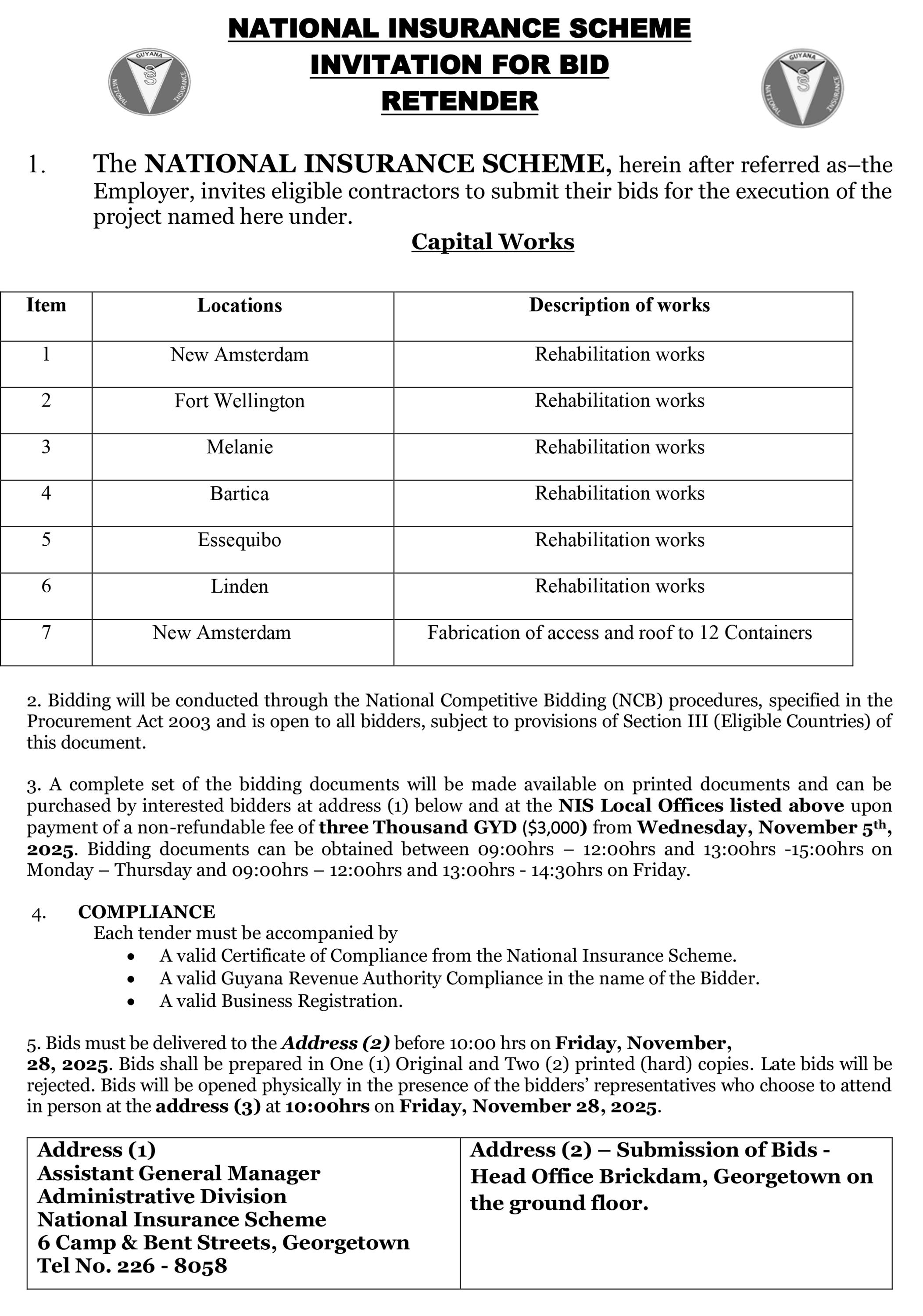
Mattress Makers is a book of voyages. A fitting subtitle might be “Around the World in Approximately One Hundred and Three Poems.”
Its ambitious sweep and subtle variation of subject matter can be dizzying.
Part of this collection’s pleasure is its panorama and inclusivity.
The remarkable poem “Waterloo: At Siewdass Sadhu’s Temple in the Sea” exemplifies this scope, moving through events, placing experiences, religions, and philosophies side by side, highlighting poignant moments in a single life.
Then there are poems so intimate they trap an emotion in form, caging it for deeper analysis—see “This Shore” and “Shadows on our Skins.”
Some of the shorter poems (some fewer than 15 lines) achieve the clarity of epigrams. “Late Tea” is an example, its final stanza possessing a laid-back concision that is beautiful and true:
And you will walk the dog
As always a brown canine Cat-sized led and leading Down strange alleys and off-pave
And you will yearn for someone
Else by your side another presence
Another pup leashed and leashing
Dusk into evening into newsprint
Room—books on walls books
On shelves among dawn bamboos
Misted with howler monkeys calling At B line—designed by Dutch canal artists
But it is in some of the longer poems that Persaud achieves a different kind of concision—one that provides context, fleshing out images and ideas. In the longer works, he is philosophical and playful, imbuing his verse with honesty, force of feeling, and surprise.
In “Colonial Crossing the River Tweed,” an appraisal of things English raises the question of how the colony made England what it is. In “For VSN”, the salient truths of Nobel Laureate V.S. Naipaul—his whoring, his abuse of women—are juxtaposed with his dedication and literary achievement.
Several of the poems carry a whiff of autobiography or seek to poetise significant historical events.
“Kalinyas and Manaharva at Jonestown” is a poignant discussion of the Jonestown tragedy, where more than 900 US citizens died in the jungles of Guyana in 1978.
“Badhase Maraj” is one of the stand-outs—a poem that realises autobiography in a few deft sentences, a beautiful rendering of a personality remembered and loved. The poem carries the deadpan humour present in others. Persaud can indeed be funny.
Mattress Makers is a significant collection—ambitious in its sweep and inclusivity, attentive to small and large ideas alike. It is a book to reread over and over again.


























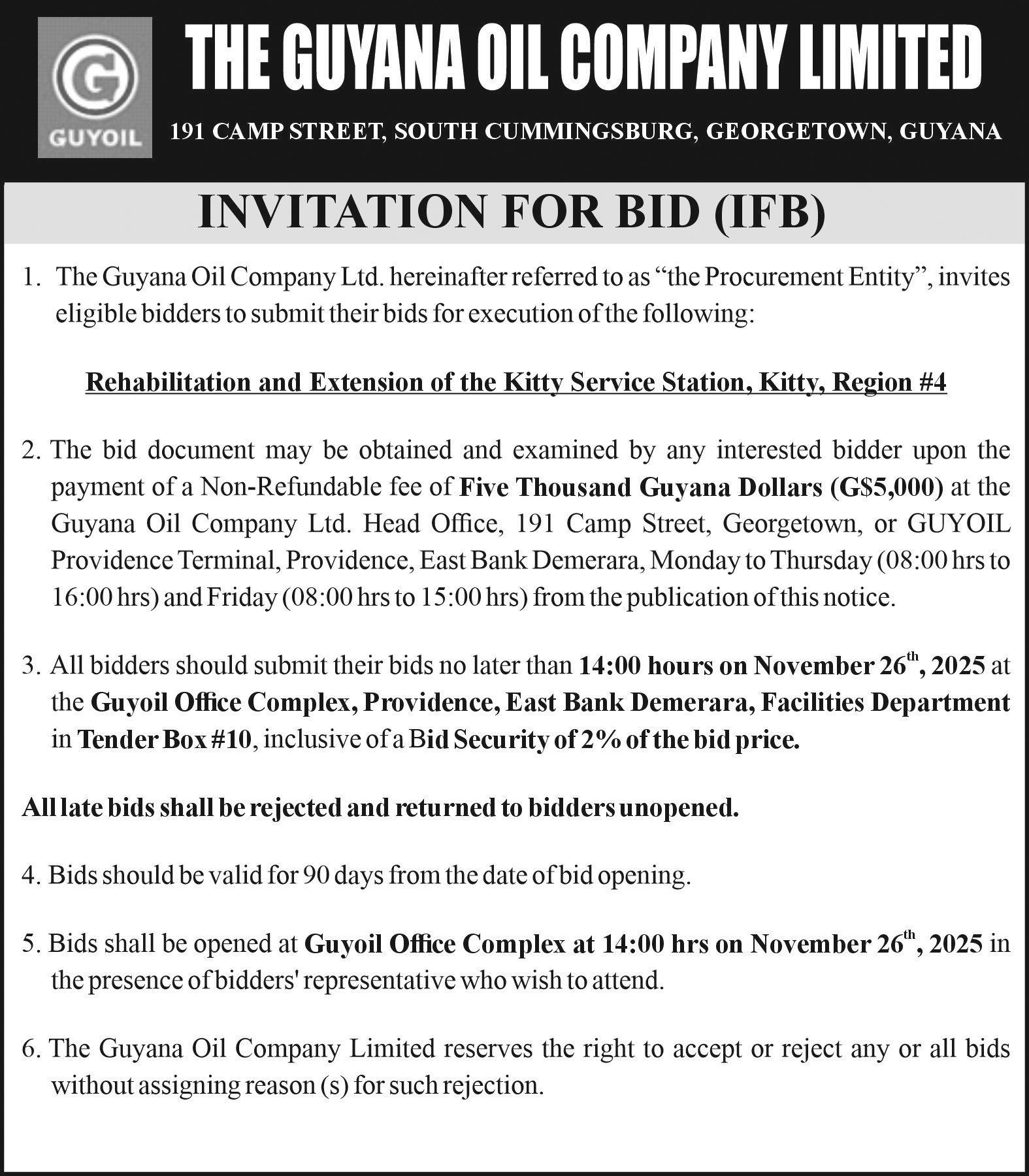


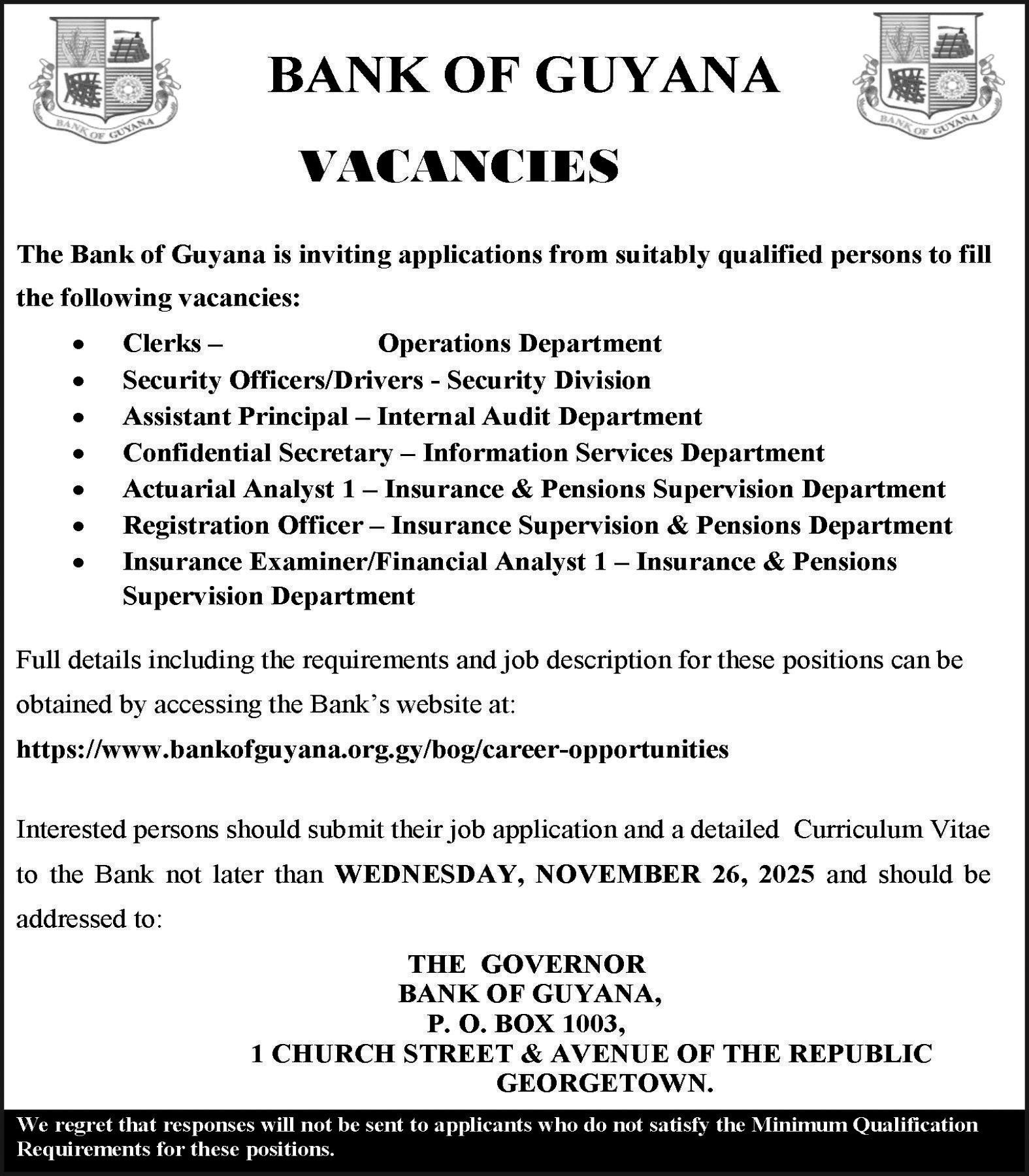





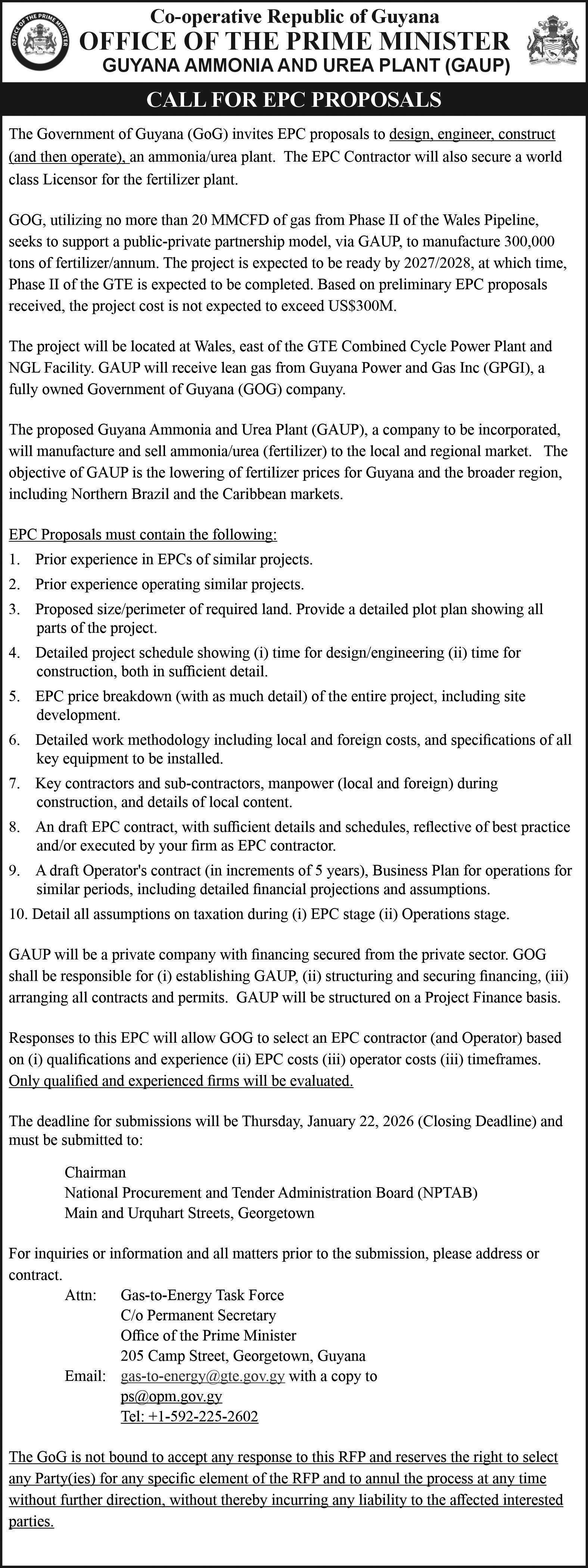




STUDY SUCCESS
Welcome, dear reading friend. Without hesitation, we say that exam preparation can greatly stress your mental and physical systems. But carefully combined techniques can help reduce stress levels. For example, physical self-care practices should directly improve your ability to manage stress and enhance mental sharpness.
Pair these with wellness techniques to positively influence your thought patterns, mindset, and study habits, helping to lower mental anxiety and pressure. Also, engage in practical study activities that help manage and reduce muscle tension and psychological stress. Be wise.
Love you.
THE PASSAGE
Comprehending the passage
Directions: Read the passage carefully and then answer the questions given below it.
The pork-knockers had accepted the fact that death could cut a man off from his dreams of wealth, his friends, and his family....
James Wellington had meant very little to me whilst he was alive. He had been a silent man who did his work well. Perhaps my youth died with James Wellington, and
some of the romantic visions I still clung to were stripped away. His death made me see myself as I was: an ambitious, selfish individual who had been helped by many people but who had helped no one in return.
I realised, too, that I was no better than the white man who had caused my father’s death.
Learning had made us not more human, but less so. Learning had not increased our knowledge of good and evil, but intensified and made more rational and deadly, our greed for gain. I could have warned Wellington as the illiterate Woody Sam had done, and he would have heeded my warning. I did not do so because the diamonds were rolling in.
The white man had done the same thing as I had done. But I did not have as much conscience. I could not go up and down the coast to look for Mr Wellington’s wife and children, for in a few months I would forget them. If they had been nearby, I would have given them all I had in the first flush of my guilt, but I was a man who went with the tide and I seldom looked back. I asked myself, “Who is the better man, the white man or me?” and I could not bear to answer the question.
[Black Midas]
1. Explain the following terms and statements in the
passage: pork-knockers, a man had dropped out of the carnival crowd, perhaps my youth died with James Wellington.
2. What was the relationship between James Wellington and the “I” narrator?
3. Describe these aspects in the passage: a) the physical aspect, b) the social aspect.
4. What does this statement mean? “The diamonds were rolling in.”
5. It is said that death to someone close affects the person in one way or another. How did the death of James Wellington affect the “I” narrator? Respond in a short paragraph.
6. What does this statement mean? “I was a man who flowed with the tide.”
7. Describe the “I” narrator in one paragraph.
8. Give a title to the passage. Justify your choice.
THE PASSAGE
Making sense of the passage
Note: One of the most helpful ways to recognising new words is through context; that is, by noting the connection in which they appear in the sentence.
Several kinds of context clues help the reader to determine the approximate meaning of the new word. Here are the first three of them. [See more next week.]
1. One kind of context clue is the synonym: that is a
November 23rd, 2025
word that has approximately the same meaning as the unfamiliar word used in the sentence. Note how the sentence is punctuated.
Example: A stiletto, or dagger, hung at the middle-aged gentleman’s side.
2. Another kind of context clue is the antonym, or word with a meaning directly contrary to that of the familiar word.
See the word that indicates the difference? Note the punctuation.
Example: Unlike the excitable wife, the schoolmaster had a phlegmatic disposition.
3. Another kind of context clue happens when sometimes a previous word, phrase, or sentence will describe a mood or a sentiment that gives meaning to the new word.
Example: It was a silent and humiliated team that trudged into the locker room after the upset. Nor did the lugubrious expression on the coach’s face serve to lift their spirits.
THE PASSAGE
Comprehending the passage
Reinforcement: To make sense of a passage – any passage – active reading and post-reading strategies do help. Connect with the text before, during, and after reading it. Ask yourself questions as you read and get answers. Tell someone or teach him
Far hence, O keep far hence, you uninitiated ones.
what you have read.
Directions: Read the passage carefully and then answer the questions given below it.
The road to Prescott winds past a deserted house that peers out sadly from a clump of tamaracks.
Long ago, it was constructed of adobe blocks laid flat and held with heavy clay. Today a skeleton-like chimney reaches above the roof and clutches to the sky.
The adobe had crumbled in gaping patches, and chunks of red lie scattered in the grass.
The window frames hang listlessly from the body of the house. Their panes have long scattered and disappeared.
A few bent shingles still curve over the roof boards.
The desolation of the house is broken only by the birds nesting in the eaves.
The passer-by gives the house a quick look and won-
ders.
What lives were once sheltered here? What circumstances enticed the occupants from this wooded spot by a winding road?
1. Look for a picture or draw one fitting the writing above, then write a story and give it life.
2. Give an understanding of each of the following word groups in the passage. road winds past, a deserted house that peers out sadly, long ago, a skeleton-like chimney, chimney clutches to the sky, window frames hang listlessly from the body of the house.
3. Tell what the last paragraph in the passage implies. Use one paragraph.
4. A mysterious place needs sensory words. Choose your words well. Choose your adjectives especially well. Pattern an essay after the structure of the given passage.


NEVER underestimate the significance of a serious blow to a child’s mouth. The consequences can be far-reaching. Sometimes a child may suffer a blow to a tooth without it being displaced from its normal position. The structures supporting it, however, may be injured. This condition is called a concussion.
The tooth is usually tender to biting pressure and may feel loose, with bleeding occurring around the crown. No treatment is indicated other than slight filing of the chewing surface if the child complains of biting sensitivity. Mobile teeth generally tighten on their own after a few weeks. Parents should be instructed to give the child a soft diet and gradually return to normal foods, according to the child’s tolerance. The future for concussed teeth is good.
A person’s dental health is primarily determined during the preschool period, and the role of the parent or guardian is essential. While tooth decay is the principal agent that affects oral health, traumatic injuries form an important part of this, especially in children.
A recent study of injuries to primary teeth found that children aged two to four years have the highest incidence. Falling has been described as the most common cause of dental injury, and the most common type of injury to the primary dentition is displacement. Other studies have shown soft-tissue injuries and enamel-dentine fractures to be the most prevalent.
Clinical evaluation of the injured preschool child can
be difficult because the dentist is often dealing with distraught parents and a frightened, unco-operative child.
The history must include the mechanism of injury and any associated trauma, such as whether a permanent tooth was knocked out. Injuries that occur closer to the ground are more likely to result in serious infection due to the greater concentration of germs at that level.
All teeth missing from the injury must be accounted for, as a tooth may sometimes be swallowed.
Crown fractures of primary teeth involving enamel only are usually not restored or filled. All that is needed is a slight recontouring of the biting edge to improve aesthetics. However, involvement of dentine in the crown fracture necessitates restoration to seal the exposed dentinal tubules that contain nerve endings.
Because of their short roots, root fractures in primary teeth are unusual. The location of a root fracture usually determines the outcome.
Only when X-rays show that the tip is broken should treatment be pursued. When the fracture is closer to the crown, the tooth usually becomes dark and loose and must be extracted.
Displacement occurs more frequently than crown or root fractures because of the resiliency of the alveolar bone and the short tooth roots. These injuries may be extrusive (the tooth being knocked outward), lateral, or intrusive (driven deeper into the jawbone). In most cases, these displaced teeth must be removed. The dentist analy-

ses the clinical picture before deciding whether extraction is necessary.
Trauma to temporary teeth can cause psychological distress to a child, unlike in
an adult. If these teeth require more than six months to be replaced by the underlying new ones, special effort must be made to preserve them in the dental arch.
Failure to do so could result in crowding (“riders”) and malocclusion (abnormal bite), unless a space retainer (a type of denture) is fabricated for the child.
Parents should not insist on extraction but allow the dentist to advise on the proper course of action, so that no hasty decision becomes a long-term regret.

